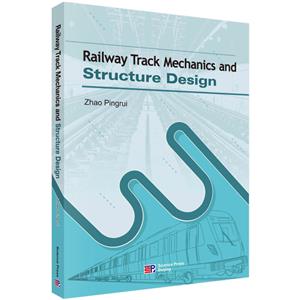-
>
公路车宝典(ZINN的公路车维修与保养秘籍)
-
>
晶体管电路设计(下)
-
>
基于个性化设计策略的智能交通系统关键技术
-
>
花样百出:贵州少数民族图案填色
-
>
山东教育出版社有限公司技术转移与技术创新历史丛书中国高等技术教育的苏化(1949—1961)以北京地区为中心
-
>
铁路机车概要.交流传动内燃.电力机车
-
>
利维坦的道德困境:早期现代政治哲学的问题与脉络
Railway Track Mechanics and Structure Design 版权信息
- ISBN:9787030661517
- 条形码:9787030661517 ; 978-7-03-066151-7
- 装帧:一般胶版纸
- 册数:暂无
- 重量:暂无
- 所属分类:>>
Railway Track Mechanics and Structure Design 内容简介
Withtherapiddevelopmentofmodernrailway,passengersandresidentsbecomemoreconcernedaboutthetrain-inducedvibrationandnoisealongtherailway.Newtechnologyneedtobeappliedtomeasure,evaluateandcontrolthevibrationandnoise.Vehicle-trackcouplingdynamicsimulationissuchaprovenandpracticaltool.Bycouplingthevehiclesystemandtracksystemthroughwheelrailinteraction,onecouplingvehicle-trackcouplingmodelcanbeestablishedandsolved.
Modernrailwayalsocallsfornewstructureandtechnology,suchasContinuousWeldedRail,highspeedturnout,slabtrack,etc.Thisbookcanprovidesufficientsupporttodevelopnewstructuresofmodernrailway.
Railway Track Mechanics and Structure Design 目录
Chapter 1 Introduction 1
1.1 Rapid Development in Rail Transportation 1
1.2 Railway Vehicle 2
1.2.1 Car body 2
1.2.2 Bogie 3
1.2.3 Wheelset 7
1.2.4 Spring element 9
1.2.5 Damping element 12
1.3 Railway Track 14
1.3.1 Rail and rail joint 15
1.3.2 Sleeper 18
1.3.3 Fastener 20
1.3.4 Ballast 21
1.3.5 Slab track 23
1.3.6 Turnout 26
1.3.7 Continuous welded Rail 27
1.4 Self-Steering of Wheel on Rail 28
1.5 Track Mechanics and Track Design 32
1.5.1 Track static mechanics 32
1.5.2 Track dynamic mechanics 32
1.5.3 Track structure design 34
Chapter 2 Track Geometry 35
2.1 Dimension of wheel set 35
2.2 Track Geometry on Tangent Track 38
2.2.1 Track gauge 38
2.2.2 Track level 40
2.2.3 Horizontal alignment 41
2.2.4 Vertical alignment 41
2.2.5 Rail inclination 42
2.3 Gauge Widening on Small Radius Curved Track 43
2.3.1 Bogie position on curved track 43
2.3.2 Track gauge widening determination 44
2.3.3 Maximum track gauge of curved track 46
2.4 Super Elevation on Curved Track 47
2.4.1 Setting of super elevation on curved track 47
2.4.2 Calculation of super elevation 47
2.4.3 The unbalanced super elevation 49
2.4.4 The maximum super elevation 50
2.4.5 Speed limit on curved track 52
2.5 Transition Curve 52
2.5.1 Function and geometry character of transition curve 52
2.5.2 Geometry condition of transition curve 53
2.5.3 Higher order transition curve 57
2.5.4 Length of transition curve 57
Chapter 3 Vertical Static Track Analysis 60
3.1 Analytioal approach of track structure under vertical wheel loading 60
3.1.1 Fundamental assumption and calculation model 60
3.1.2 Differential equation of continuous beam model 61
3.1.3 Basic mechanical parameters 64
3.1.4 Calculation under group wheels 68
3.2 Finite Element Approach to Calculate the Track Mechanical Response 69
3.2.1 Discretization of track structure 69
3.2.2 Stiffness matrix of beam element 70
3.2.3 Stiffness matrix assembling of beam elements 71
3.2.4 Computational model and matrix equation of track structure 71
3.3 Quasi-static Analysis of Track Responses 72
3.3.1 Speed coefficient 73
3.3.2 Unbalanced loading coefficient 74
3.3.3 Quasi-static analysis method 75
3.4 Strength Checking of Track Components 76
3.4.1 Rail stress analysis 76
3.4.2 Sleeper strength checking 78
3.4.3 Ballast stress checking 80
Chapter 4 Ballast Track Design 83
4.1 Principles of Defining Ballast Track 83
4.1.1 Ballast track 83
4.1.2 Characteristics of railway track 83
4.1.3 Track structure and operation condition 85
4.1.4 Track structure selection 86
4.2 Rail and Rail Joint 88
4.2.1 Rail 88
4.2.2 Rail joint 89
4.3 Sleeper 91
4.3.1 Timber sleepers 91
4.3.2 Concrete sleepers 92
4.3.3 Wide sleeper 94
4.3.4 Frame sleepers 95
4.4 Fastener 96
4.4.1 Categories of rail fastener 96
4.4.2 Fastener clip 97
4.4.3 Rail pad 98
4.5 Ballast Bed 99
4.5.1 Ballast materials 99
4.5.2 Thickness of ballast 100
4.5.3 Ballast mat 101
4.5.4 Ballast flow and deformation 102
4.5.5 Ballast tamping and stabilizing 103
4.5.6 Ballast cleaning 104
4.6 Subgrade 104
4.6.1 Subgrade strength checking 105
4.6.2 Dynamic stability 106
4.6.3 Residual deformation and fatigue behavior 107
4.6.4 Hardened subgrade 107
4.7 Ballast Track Quality 108
4.7.1 Factors of deterioration rate 109
4.7.2 Ballast track settlement 109
4.7.3 Optimum of ballast track 111
Chapter 5 Ballastless Track Design 113
5.1 Ballastless Track Design Requirement 113
5.1.1 Ballastless track design task 113
5.1.2 Ballastless track design requirement 115
5.1.3 Ballastless track function design 117
5.2 Ballastless Track Analysis under Wheel Load 118
5.2.1 Analysis method in different country 119
5.2.2 Composite beam on elastic foundation model 120
5.2.3 Beam-plate model on elastic foundation 123
5.2.4 Parameters in beam plate model 130
5.2.5 Parameter study of slab track 137
5.3 Thermal Stress Analysis of Ballastless Track 139
5.3.1 Temperature parameters 140
5.3.2 Thermal stress in continuous track slab 142
5.3.3 Thermal stress in track slab with certain length 153
5.3.4 Warping stress in track slab 154
5.4 Influence of Uneven Settlement 159
5.5 Ballastless Track Structure Design 165
5.5.1 Ballastless track structure design method based on allowable stress 166
5.5.2 Load and load combination 167
5.5.3 Structural coefficient 170
Chapter 6 CWR Analysis and Design 176
6.1 Introduction 176
6.2 Basic Principal 176
6.2.1 Basic thermal stress 176
6.2.2 Longitudinal resistance 178
6.2.3 Basic diagram of thermal force distribution 182
6.3 Stability Analysis of CWR 186
6.3.1 Factors i
- >
莉莉和章鱼
莉莉和章鱼
¥14.4¥42.0 - >
巴金-再思录
巴金-再思录
¥15.7¥46.0 - >
李白与唐代文化
李白与唐代文化
¥9.9¥29.8 - >
罗曼·罗兰读书随笔-精装
罗曼·罗兰读书随笔-精装
¥32.9¥58.0 - >
名家带你读鲁迅:故事新编
名家带你读鲁迅:故事新编
¥13.0¥26.0 - >
小考拉的故事-套装共3册
小考拉的故事-套装共3册
¥36.7¥68.0 - >
上帝之肋:男人的真实旅程
上帝之肋:男人的真实旅程
¥20.2¥35.0 - >
史学评论
史学评论
¥14.4¥42.0
-
铁道之旅:19世纪空间与时间的工业化
¥33.4¥59 -
高速列车牵引电机微弱故障诊断与溯源研究
¥22.1¥49 -
不良情绪应急处理包--孤独感
¥12.9¥30 -
不良情绪应急处理包--精神内耗
¥12.9¥30 -
孩子、家庭和外部世界
¥17.8¥56 -
北魏政治史(二)
¥26.2¥70

















